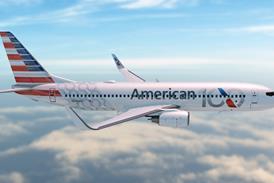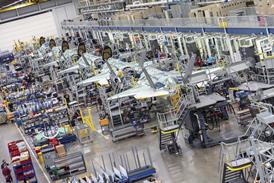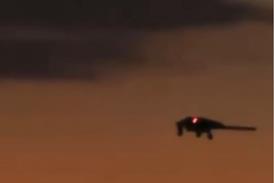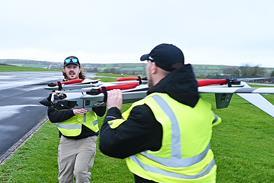Bigger does not automatically mean better. While, externally, the E/F is essentially a C/D scaled up by 25%, there is more to the Super Hornet design than the photographic enlargement of the original F/A-18 blueprints. "The E/F is a balanced design involving five variables: range, payload, bringback, survivability and growth," says Jim Young, Boeing's division director, F/A-18 programme engineering.
The E/F's fuselage is 860mm (34in) longer, the wing is 25% larger, the horizontal stabilator 36% bigger, the vertical tails 15% larger and the wing leading-edge extensions (LEX) enlarged by 34%. Maximum take-off weight is up by 27%, to 30,000kg (66,000lb), and maximum thrust is up 25%, to 44,000lb (196kN).
The centre fuselage plug and bigger wing box increase internal fuel capacity by 33%, to 6,560kg. As the E/F can carry larger external tanks - 1,800 litres (480USgal), compared with 1,250 litres for the C/D - fuel capacity can be increased further, to 11,000kg with three tanks and 14,000kg with five tanks, enabling theF/A-18 to be used for the first time as an aerial refuelling tanker.
Wing area is increased to 46m2 (500ft2) to reduce approach speed at the E/F's higher carrier landing weight. The E/F is designed to land 10kt (18km/h) slower than the C/D. The longer span has allowed the addition of another underwing pylon per side, giving the E/F 11stores stations - two wingtip missile rails, six underwing pylons, two inlet stations and a centre fuselage pylon. Up to 8,050kg of external stores can be carried, an increase of 20%.
The wing design reintroduces the leading-edge "snag" that was a feature of the original A/B wing, but was removed during development to alleviate flutter problems. The E/F wing is thicker and stiffer, allowing reintroduction of the snag, which increases roll control power by creating a vortex that energises the airflow over the aileron.
The LEX were enlarged and reshaped early on to maintain C/D manoeuvrability levels. Because the E/F is larger, with greater inertia, the sizes, deflections and rates of all control surfaces had to be increased. The hydraulic system switches from 207bar to 345bar (3,000lb/in2 to 5,000lb/in2) at high speed and high angle of attack (AoA) to increase control power.
Two new control surfaces were added: LEX spoilers and LEX vents. Located at the junction of the LEX and the leading-edge flaps, the vents open automatically at high AoA to allow high-energy air to flow over the wing-fuselage blend. "Windtunnel testing said they were needed to break up the vortex on the tail. Flight testing showed they were not. They will be out by full-rate production," says Young.
The spoilers are multifunction surfaces. Located on the upper surface of each LEX, the spoiler acts primarily as a speedbrake. To reduce weight, the E/F lacks the C/D's upper-fuselage airbrake. Instead, the flight control system has a speedbrake function that deflects the spoilers up, ailerons up, trailing-edge flaps down and rudders out.
To reduce radar signature, the E/F lacks the C/D's LEX fences and inlet diverter ramps, so the spoilers are used also to control the LEX vortices at high AoA and vent intake boundary-layer air at high Mach numbers. The LEX spoilers also increase nose-down pitch control authority at high AoA.
The E/F has a quadruplex digital fly-by-wire flight control system developed by Lockheed Martin. To reduce weight, the C/D's mechanical back-up system has been eliminated and replaced with a direct electrical link providing a "get home" capability. The only control cable in the aircraft goes to the arrester hook.
Elimination of the mechanical linkage has allowed the aircraft's longitudinal static stability to be reduced, to improve manoeuvrability. To allow removal of the mechanical back-up controls, redundancy in the electrical generation system has been increased substantially. Whereas the C/D has three independent power sources, the E/F has nine.
ASPECTS OF SURVIVABILITY
The most noticeable external difference between the E/F and previous F/A-18s is in the engine intakes. The "caret" inlets are also the most obvious sign of the survivability improvements designed into the aircraft.
Boeing and the US Navy prefer to talk about survivability, rather than stealth. They acknowledge the limits to the signature reduction that can be achieved by modifying an existing design, but argue there is more to survivability than low observability. In the E/F, reduction of the frontal radar cross-section is combined with a reduced vulnerable area and improved electronic countermeasures.
The inlets, which are enlarged to handle the airflow for the more powerful engines, are angled to align with the wing leading edges. Planform alignment reduces radar returns and can be seen on various access panels and doors, which have "sawtooth" edges. Inside the inlet, just forward of the engine, is a device that blocks radar returns from the fan face.
Other signature-reduction measures include the use of radar-absorbing materials in the inlets, nose radar cavity and cockpit - the major contributors to frontal-aspect cross-section. The result is an "order of magnitude" reduction in signature over the night-strike C/D, itself a "reduced-observable" aircraft, the navy says. "The E/F, with external stores, is six to 10 times more survivable," says Sears.
While bigger than the C/D, the E/F's vulnerable area is 13-25% smaller. The biggest contributor is a dry bay fire-suppression system that can automatically releases inert gas to prevent a fuel explosion. Improved polyurethane tank bladders, meanwhile, minimise fuel leakage.
Redesign or relocation of components and increased redundancy also reduce vulnerability. Fault management software can reconfigure the flight control system automatically if a control surface is damaged. Flight tests have simulated the failure of a stabilator, the remaining control surfaces compensating for the loss.
An improved countermeasures suite completes the survivability enhancements. The E/F is planned to receive the Integrated Defensive Electronic Countermeasures (IDECM) system, combining the improved ALR-67(V)3 radar warning receiver, ALQ-214 radio-frequency countermeasures subsystem and ALE-55 fibre-optic towed decoy.
As the ALQ-214 and its ALE-55 decoy are still under development by Lockheed Martin Sanders and ITT, the E/F will be equipped initially with Raytheon's ALE-50 towed decoy. A three-decoy dispenser is mounted under the fuselage, between the engines.
THE DIFFERENCE INSIDE
Although externally it is a scaled-up C/D, the E/F is different internally to previous F/A-18s. Structural commonality is only 10%, the E/F airframe having been redesigned extensively to reduce weight and cost. "We designed the structure to accommodate growth," adds Young.
Use of carbonfibre composite has more than doubled, to 22% of the structural weight, with increased use in the centre and aft fuselage, wing leading and trailing edge flaps and inlet ducts. An improved stiffness/strength carbonfibre, IM7, is used in the wing and tail skins and an improved toughness epoxy resin, 977-3, is used in all carbonfibre applications. Says Young: "We went to IM7/977-3 to improve damage tolerance. It's also easier to work with."
Use of aluminium alloy has dropped to 29%, from 50% in the C/D. The enlarged LEX and ailerons are still aluminium. "The LEX did not show a benefit with composites, neither did the ailerons," Young says. There is a slight increase in titanium in the E/F. "The wing carrythrough bulkheads were aluminium; they are now titanium for damage tolerance. That was a lesson learned from the C/D."
The E/F's landing gear, strengthened to handle the increased weight, is the first production application of Aermet 100 steel: the C/D gear used 300M steel. Says Young: "300M is brittle, with a small critical crack size. Aermet has the same static strength as 300M, but higher damage tolerance. The critical crack size has gone from 0.05in to 0.5-0.75in."
While the E/F's structural concept is based on the C/D's, the manufacturing execution has changed substantially. The focus has been on reducing parts count to simplify assembly and save money. "Our philosophy was that we would combine parts if they didn't move, weren't of different materials and didn't need to be removable," Young says.
The result is 42% fewer parts than the C/D, with savings in fabrication, tooling and assembly costs. The E/F has 8,100 parts against the 14,100 in the C/D structure. Parts count in the wing and tails is more than halved, from 4,100 to 1,800. The nose barrel bulkhead has gone from 90 parts to just one, which is lighter as well as quicker and cheaper to produce, and similar savings are repeated throughout the aircraft.
"Design for assembly", as Boeing calls it, has contributed to the E/F being under its specification empty weight of 13,860kg throughout the development programme. At its first flight in November 1995, the E/F was more than 450kg below weight and, with flight testing almost complete, the aircraft remains underweight, Young says.
POWER WITH PEDIGREE
The F414 afterburning turbofan powering the E/F was developed from the F404, which powered all previous F/A-18s, by way of the F412 developed for the cancelled A-12. The F414 is essentially a scaled-up F404, but incorporates technology from other General Electric fighter powerplants, such as its advanced YF120.
Uninstalled maximum thrust of the F414-400 is in the 196kN class, an increase of 35% over the original F404-400, and 25% over the enhanced F404-402 powering the latest C/Ds. "The navy took a hard line on growth. It wanted the bigger engine despite the cost because it offered the best combination of affordability and capability,"Steidle says.
Compared to the F404, the F414 has a 16% higher airflow, an increased overall pressure ratio of 30:1 and a higher thrust-to-weight ratio of 9:1. Despite this, the F414 has the same length and aft diameter as the F404. GE cites the use of integrally bladed disks (blisks) as one reason for the improved performance.
The F414 fan provides the increased airflow with the improved birdstrike resistance developed for the F404/RM12 that powers the single-engined Saab Gripen. The second and third stages of the three stage fan form a tandem blisk, reducing weight and improving performance and durability.
The F414 core was developed originally for the F412. The first three stages of the seven stage high-pressure compressor are blisks, the first two forming a tandem blisk. The combustor features multi-hole cooling to reduce metal temperatures and extend life. The single stage high-pressure turbine has monocrystal blades and vanes, as does the cooled single-stage low-pressure turbine.
The afterburner design is adapted from the YF120, using air-cooled radial flameholders. The exhaust nozzle, based on the F404 design, incorporates ceramic-matrix composite flaps and seals to increase life. The outer bypass duct is carbonfibre composite, and improved materials are used elsewhere in the engine to reduce weight and extend life.
For the first time in an F/A-18, the engine is controlled by a dual-channel full-authority digital electronic control (FADEC) system. This controls fan and compressor variable geometry, In flight testing, the FADEC has allowed fine tuning of the engine.
LAYING THE FOUNDATIONS
As a cost-saving measure early in the E/F programme, the USN elected to retain the C/D's avionics. The improved systems originally planned will be introduced as block upgrades, beginning around 2005.
Overall, the E/F avionics are 90% common with those of the latest C/Ds. Software commonality is as high as 99% in the sensors and as low as 67% in the flight controls. Although an advanced crew station was shelved to reduce costs, the controls and displays are improved over those in the C/D.
The main cockpit changes are a new touchscreen upfront control display and a larger multipurpose colour display. The C/D's mechanical upfront control panel, mounted just below the head-up display (HUD), is replaced with a 75 x 130mm monochrome liquid-crystal display. This can be used as data-entry touchpad for the communication/navigation/identification system, or as a display for the radar, forward-looking infrared sensor and electronic warfare system.
The 130mm-square left- and right-side multifunction displays are unchanged from the C/D, but the central multipurpose display, enlarged to 160mm, is now a colour liquid-crystal display for increased reliability and better readability in sunlight. Its primary purpose is to show a digitally generated moving map, with information superimposed. "This is a situational awareness display," says Young. "It shows datalink information, flightpath, IDECM threats, etc." Another change is replacement of the engine/fuel display with a programmable monochrome active-matrix liquid-crystal display. This shows nozzle positions and fuel tank contents graphically.
Since the decision was taken in 1991 to stay with C/D avionics, those systems have been improved substantially. The most significant upgrade came in 1994, with introduction the Raytheon APG-73 radar. This is an upgrade of the F/A-18's original APG-65 multimode radar, with increased processor speed and memory and higher reliability. The APG-73 retains the -65's mechanically scanned antenna, but the new receiver module has growth to accommodate an active electronically scanned array (ASEA).
An ASEA is top of the list of upgrades planned for the E/F, although funding is yet to be identified. Meanwhile, development of the Advanced Targeting Forward-Looking Infra-Red (ATFLIR) pod is under way at Raytheon. Due to enter service in 2001, the ATFLIR will replace the AAS-38 Nite Hawk targeting pod carried by C/Ds and provide increased range and resolution.
STRIKING CHARACTER
Growth provisions for these and other upgrades have been designed into the E/F, which will enter service with about 40% growth capacity in electrical power, air cooling and equipment volume. The USN says that the C/D has just 0.2ft3 of space left for system growth; the E/F will enter service with 17.5ft3 of useable growth space, Young says.
Taken together, the improvements incorporated in the E/F produce an aircraft with a character distinctly different to the C/D's. While still a multirole machine like its predecessors, the E/F embodies a swing to the strike side of the fighter/attack equation, with its emphasis on range and payload.
Carrier-based range has been the most criticised deficiency of the F/A-18 since first introduced. Because of its increased internal and external fuel capacity, the E has a combat radius around 40% greater than the C. The exact range increase will depend on mission profile and the final results of flight testing.
The navy says the single-seat E's combat radius on a fighter escort mission is increased by 26%, to 780km, compared with the latest C. Interdiction radius with three tanks and four 450kg bombs is increased by 38%, to 940km, assuming a hi-lo-lo-hi mission profile, and to almost 1,180km, an increase of 35%, with a hi-hi-hi profile.
Additionally, the E/F's ability to carry four 1,800 litre external tanks and a centreline "buddy" refuelling store will allow the F/A-18 to be used as an aerial refuelling tanker. The E/F will have a similar fuel offload capability to the KA-6 tanker, the USN says, allow a receiving E to extend its radius to beyond 1,700km.
Combined with the new generation of stand-off weapons, the E/F upgrade will increase the F/A-18's strike reach substantially, to beyond 1,900km when the Stand-Off Land Attack Missile Expanded Response (SLAM-ER) is carried and buddy refuelling is used.
Payload flexibility is a major advantage claimed for the E/F, with its additional underwing pylons. The USN says that campaign analyses show that the two extra stores stations, the "buddy" aerial refuelling capability and the E/F's size relative to the A-6 and F-14 - allowing more aircraft on the carrier deck - to be "powerful attributes".
In addition to increased payload, the extra pylons allow a wider range of weapons to be carried. The new outer wing stations are limited to 520kg capacity, but are intended to allow the E/F to carry self-protection weapons such as the High-Speed Anti-Radiation Missile (HARM) in addition to a full strike mission load. Whereas the E/F will be able to carry two HARMs as well as four Joint Stand-Off Weapons (JSOWs), the C/D would have to offload two JSOWs to carry the HARMs.
This increased flexibility to carry high-value munitions depends on another aspect of the E/F upgrade: its ability to return those weapons to the carrier deck if they are not used. The weight of fuel and stores that the F/A-18 can return to the carrier - called "bringback" payload in navy parlance - has been eroded by weight growth over the aircraft's life.
The USN says the C/D's bringback payload is now just over 2,500kg - 1,800kg of fuel and 700kg of weapons - under normal operating conditions. The E/F's higher landing weight will increase this to almost 4,100kg, including up to 2,200kg of weapons. This will enable the aircraft to return to the carrier with weapons such as the 900kg-class JSOW. The USN's newest strike weapons, such as the JSOW and SLAM-ER, are shaped for reduced observability, which will contribute to the survivability variable in the E/F upgrade equation.
The E/F upgrade attempts to balance the demands for increased range, payload, bringback and survivability with the need for affordability. Ultimately, however, it is the E/F's growth capacity that could prove most valuable. The upgrade aims to restart the growth cycle and take the F/A-18 to 2020 and beyond.
Source: Flight International























